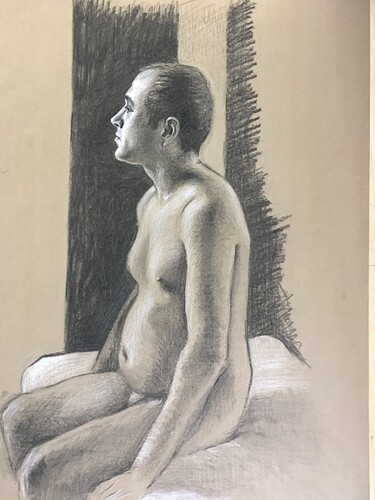The Art of Reduction and Rhythmic Research
In my work as an artist, I’ve learned that the greatest skill often lies in discernment — in knowing not what to put in, but what to leave out. What negative spaces to make. What details to ignore, so that the whole can resonate
. It’s not the precision of addition, but the power of omission that allows a piece to breathe.
I’m beginning to think research might need the same. Perhaps we should start by asking: What not to do?
Very much encouraged by @JonahW rethinking of how we might do research, and by @rufuspollock sharing the whole of the research group notes from 2023 onwards — and the recent Dev Spaces document — I’ve tried to take a step back and sense into the wider field. Not just the explicit content, but the drift, the emotional undercurrent, the unspoken fatigue — not just here, but a saturation across many developmental and intentional spaces worldwide.
When research produces 50 dense pages of words without a felt shift in clarity, alignment, or consequence in the community, something is stalling in the information–meaning–action arc. It’s not a failure of intelligence or care — but a sign that the system is generating more than it can metabolize.
I feel it in my own writing. It helps me clarify my thinking, but rarely lands anywhere beyond me. I imagine others might feel this too. The most meaningful impact of Dev Spaces may be in the authors’ and contributors’ minds, not the wider community’s direction. Perhaps we should be designing ways for all 2R member to participate in action research. Perhaps the goal of research is not content, but the development of the mind and soul of participants?
Meanwhile, the sheer global volume of thoughtful output begins to resemble a semantic traffic jam — full of great material, no flow. Too much playing to the audience, not enough players.
Engines idle, the heat rises, and we grow restless. A traffic jam of meaning with nowhere to go.
Perhaps we’re facing semantic inflation: more words, less weight. The system over-communicates to compensate for a lack of grounding or shared traction. Great ideas, but no place to land.
There’s also, I think, a scattering of purpose — divergent inquiries, multiple agendas, insufficient containment. Without scaffolds for convergence — shared questions, decision points, reflection rituals — we risk writing that floats free of function. Overwhelm becomes structural, not just individual.
From a systems lens, this looks like:
-
Breakdown in feedback loops — ideas circulate but don’t cycle back as learning
-
Mismatch of scale — content outpaces our collective capacity to process or apply it
-
Loss of boundary — without timeframes, formats, or editorial constraint, coherence dissolves
In Action Research, as I studied with Hilary Bradbury, the question might be:
What is this writing doing in the system?
Is it helping the system learn itself forward? Or is it extending the loop of observation without action?
Some Possible Correctives
-
Write only what we’re prepared to act on or reflect on together
-
Practice brevity: set word limits, co-synthesis timelines
-
Translate content into condensed emotional, visual, somatic, artistic, or oral formats
-
Follow each piece with reflection: What shifted? What’s now possible?
These shifts don’t reduce depth — they refocus it.
A Co-Inquiry Cycle for the Second Renaissance
We might explore a Post-Academic Research mode — not rejecting rigor, but repatterning it around relevance, coherence, and participation. A proposal for co-inquiry, not solo performance. Here’s a working sketch:
-
Start with Real Tension — a felt breakdown or opening
Where is meaning leaking? Where is action stuck?
-
Work in Mini-Collectives — 3–7 people with shared stake
Inquiry is dialogic, not solitary
-
Write to Orient, Not to Impress — short, clear, useful
Format: 2-page brief, one diagram, one open question
-
Embed Feedback Loops — every cycle must land somewhere
What changed because of this?
-
Publish Midstream — living documents, changelogs, iterative outputs
-
Evaluate by Systemic Contribution — not novelty, but clarity, traction, and resonance
Let repetition fall away
A Rhythm for Living Research: Lunar and Seasonal Containers
To help this model live, we could anchor our work in natural rhythms — both lunar and seasonal. This is not the content of our research, but the how of its unfolding:
Lunar Cycle
Offers a monthly rhythm:
-
 New Moon: set intentions, initiate inquiry
New Moon: set intentions, initiate inquiry -
 First Quarter: focus, prototype
First Quarter: focus, prototype -
 Full Moon: reflect, share
Full Moon: reflect, share -
 Last Quarter: integrate, close
Last Quarter: integrate, close
Seasonal Cycle (quarterly)
Supports broader coherence:
-
 Spring: emergence
Spring: emergence -
 Summer: focus and build
Summer: focus and build -
 Autumn: harvest and process
Autumn: harvest and process -
 Winter: reflect and rest
Winter: reflect and rest
These temporal containers are not aesthetic flourishes — they create coherent pulses, while preserving freedom to follow wherever our research hearts desire to go. They let the field breathe, metabolize, and self-correct. They restore body and planetary rhythm where we’ve slipped into constant weary output.
We could begin as simply as naming the upcoming New Moon (October 13) as the start of a prototype cycle:
→ One pod. One shared question. Four weeks.
Let the system feel itself again.
Let’s reclaim the art of reduction — and get some breathing space into our collective knowing, and take discoveries into direct action.
Perhaps folks can add ideas to deepen/sharpen this?
I always use AI to fix my dyslexic mess, and it m-dashes everywhere, sorry.
